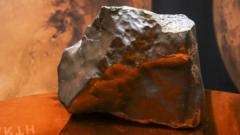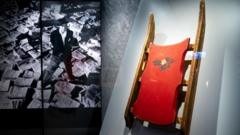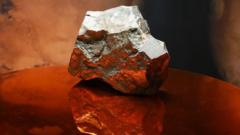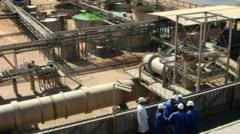Following the auctioning of a Martian meteorite from Niger for $4.3 million, officials demand explanations regarding its sale and export legality, emphasizing the importance of cultural heritage.
Niger Demands Accountability After $4.3 Million Martian Meteorite Auction

Niger Demands Accountability After $4.3 Million Martian Meteorite Auction
A rare Martian meteorite discovered in Niger was auctioned for millions in New York, raising concerns over legality and heritage.
The recent auction of a Martian meteorite, the largest of its kind ever found on Earth, in New York for a whopping $4.3 million has ignited a firestorm of controversy in Niger. This rare specimen, known scientifically as NWA 16788, was found two years ago in the Sahara Desert's Agadez region. Renowned palaeontologist Professor Paul Sereno voiced strong objections to the sale, contending that the precious artifact should have remained in Niger, the nation where it was discovered.
The meteoritic jewel was sold anonymously at Sotheby's, prompting Niger's government to investigate the circumstances surrounding its export and potential illegal trafficking. Sotheby’s, however, stands firm in its assertion that all procedures were followed correctly in accordance with international law.
Nigerien authorities expressed dissatisfaction, questioning if the sale's legality was appropriately handled. The country's statement mentioned potential breaches of law regarding the export of such significant cultural heritage items. Investigations into the meteorite's journey have revealed limited information about how it made its way to an auction house in the United States, raising further red flags.
Discovered in a region known for its favorable conditions for meteorite preservation, NWA 16788 was collected by an undisclosed meteorite hunter and, according to reports, was eventually sold to an international dealer and temporarily displayed in Italy. The University of Florence examined the meteorite before its public debut in New York, missing some slices retained for further analysis.
Prof. Sereno, who has dedicated years to highlighting Niger's natural and cultural treasures including dinosaur fossils, argues that international laws protecting such artifacts should extend to meteorites. While Niger's existing heritage law does reference mineralogical specimens, it lacks specific coverage for meteorites.
Globally recognized treaties have attempted to regulate the trade of cultural heritage items; however, the status of meteorites remains ambiguous. Niger has pursued its own protective legislation, yet its capabilities of enforcing them have come under scrutiny, particularly in light of how a substantial artifact like NWA 16788 could be removed unnoticed.
Similar issues have plagued other African nations such as Morocco, home to thousands of meteorites. Jean R. Gordon’s book highlights this trend, citing Morocco’s historical challenges with the export of its extraterrestrial heritage. Moroccan geologist Prof. Hasnaa Chennaoui Aoudjehane advocates for stricter regulation on meteorite trade while lamenting the ongoing struggle to maintain these national treasures.
As Niger seeks answers about the auction, Prof. Sereno hopes the incident will catalyze a movement within Niger to safeguard its heritage. He stresses that any future displays of the Martian meteorite should acknowledge Niger's rightful claim, enforcing a broader understanding that artifacts from outer space hold cultural significance as vital as traditional historical objects.















